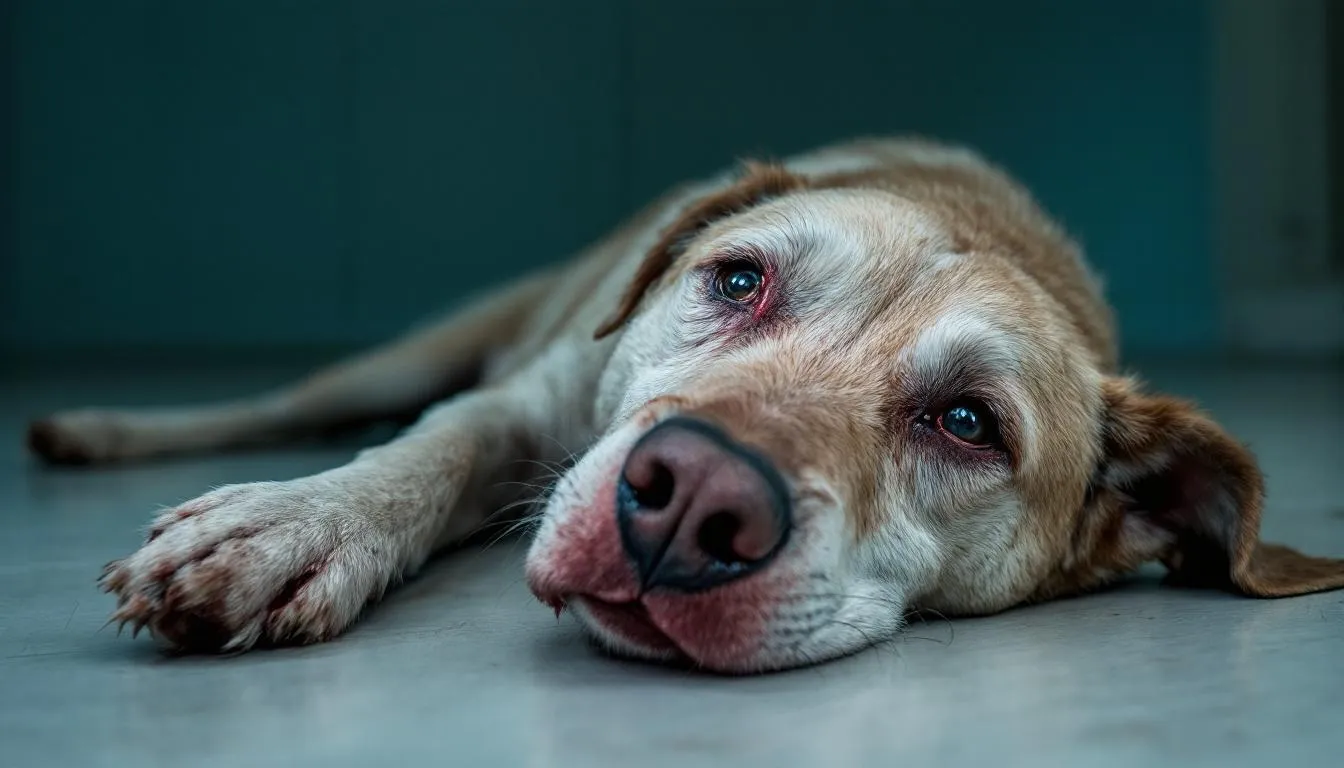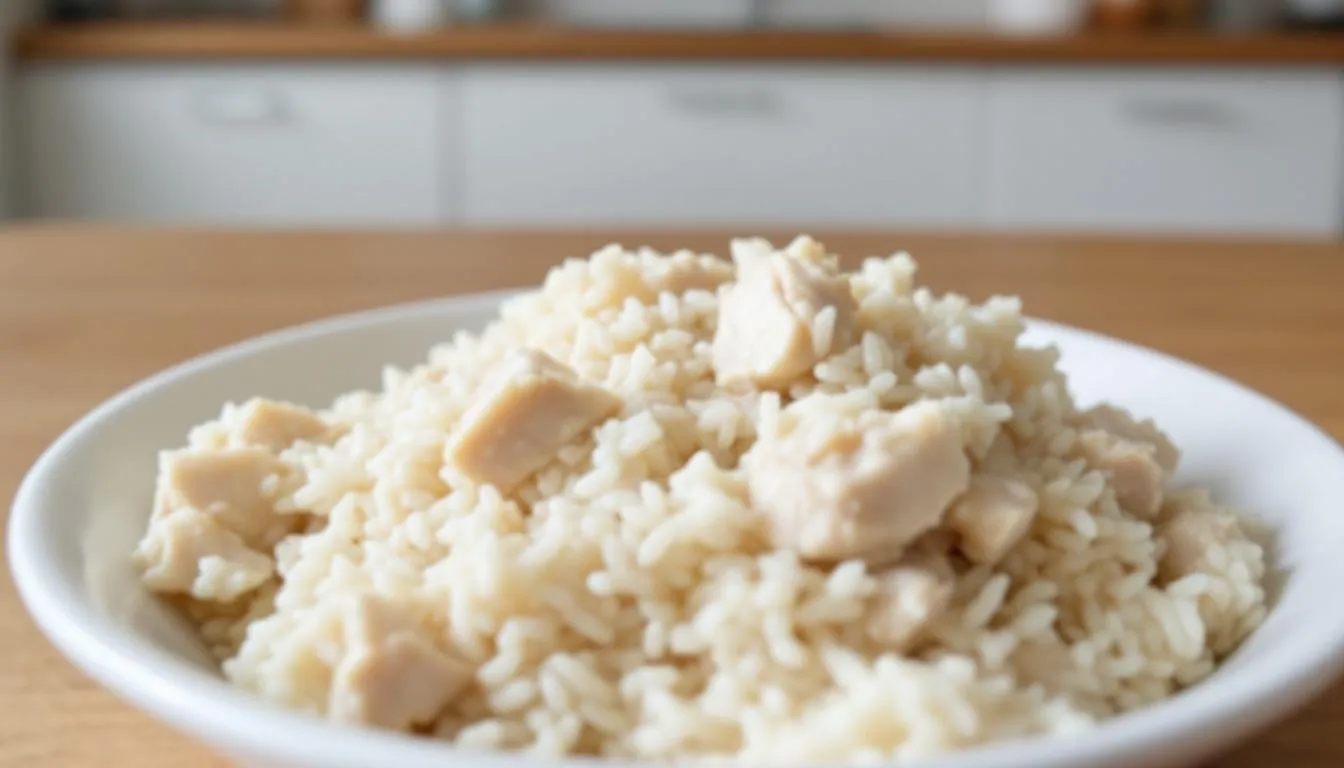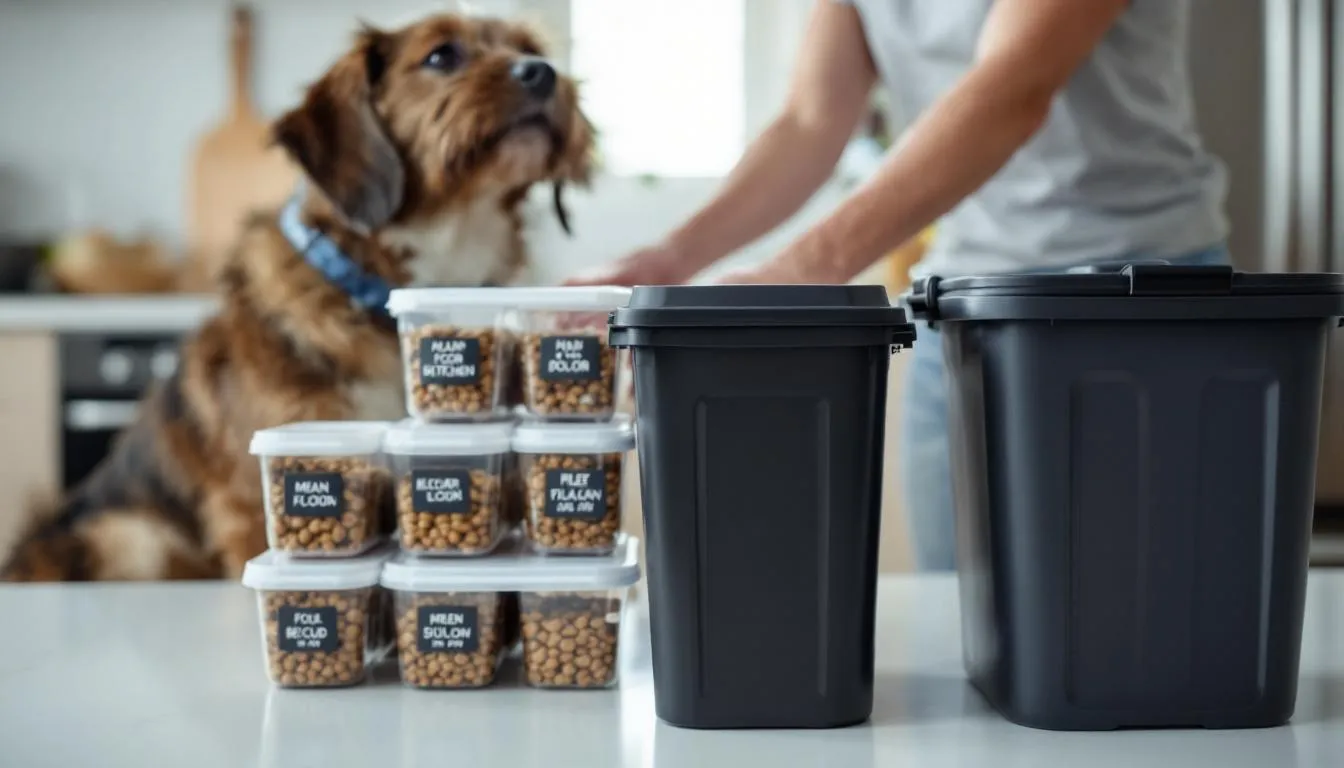Key Takeaways
- Dog diarrhea and vomiting together can indicate anything from mild dietary upset to life-threatening emergencies requiring immediate veterinary care
- Emergency signs include blood in vomit or stool, repeated vomiting (3+ times in 24 hours), dehydration symptoms, and lethargy in puppies or senior dogs
- Withhold food for 12-24 hours during active symptoms, offer small amounts of water frequently, and monitor for worsening conditions
- Common causes range from dietary indiscretion and stress to serious conditions like bloat, intestinal blockages, and parvovirus
- Most mild cases resolve within 48 hours with proper supportive care, but persistent symptoms require professional veterinary evaluation
Dog diarrhea and vomiting together can indicate anything from mild dietary upset to life-threatening emergencies requiring immediate veterinary care
Emergency signs include blood in vomit or stool, repeated vomiting (3+ times in 24 hours), dehydration symptoms, and lethargy in puppies or senior dogs
Withhold food for 12-24 hours during active symptoms, offer small amounts of water frequently, and monitor for worsening conditions
Common causes range from dietary indiscretion and stress to serious conditions like bloat, intestinal blockages, and parvovirus
Most mild cases resolve within 48 hours with proper supportive care, but persistent symptoms require professional veterinary evaluation
When your dog experiences both vomiting and diarrhea simultaneously, distinguishing between a minor upset and a life-threatening emergency can mean the difference between home care and emergency surgery. These symptoms represent some of the most common reasons pet owners seek veterinary attention, yet many cases can be managed effectively at home with proper guidance and careful monitoring.
Understanding when to provide supportive care versus when to rush to the veterinary clinic requires recognizing specific warning signs and knowing your pet’s individual risk factors. This comprehensive guide will help you navigate these challenging situations with confidence, ensuring your dog receives appropriate care while avoiding unnecessary panic.


When Dog Diarrhea and Vomiting Becomes an Emergency
Certain combinations of symptoms always warrant immediate emergency care, regardless of your dog’s age or health status. When dog vomiting occurs three or more times within 24 hours combined with frequent, watery diarrhea, your pet’s condition can deteriorate rapidly due to fluid and electrolyte losses.
Blood in vomit or stool represents one of the most serious emergency signs requiring immediate veterinary attention. Vomit containing bright red blood or material resembling coffee grounds indicates active bleeding in the digestive tract. Similarly, bloody diarrhea ranging from bright red streaks to dark, tarry stools suggests significant intestinal inflammation or injury.
Dehydration develops quickly when dogs cannot retain fluids. Signs of severe dehydration include sunken eyes, dry sticky gums that feel tacky to touch, skin that remains tented when gently pinched, and progressive weakness. These symptoms can develop within a few hours in small dogs and puppies, making rapid assessment crucial.
Puppies under six months and senior dogs over seven years face higher risks for rapid deterioration due to their limited physiological reserves. Additional emergency signs include pale or white gums, a distended or hard abdomen, fever, inability to keep even small amounts of water down, and collapse or extreme lethargy.
The verification successful waiting process at emergency clinics prioritizes cases based on severity, so documenting specific symptoms and their timeline helps veterinary staff triage your pet appropriately. Evidence gathered from clinical signs and diagnostic tests helps confirm the diagnosis and guide treatment.
Recognizing Emergency Care Level Symptoms Severity
Understanding symptom severity helps determine appropriate response levels and guides treatment decisions. Mild cases typically involve one to two episodes of your dog's vomiting accompanied by soft but formed stool, with dogs maintaining normal energy levels and continuing to show interest in water or food.
Moderate symptoms present as multiple vomiting episodes over several hours, loose diarrhea that may contain mucus, reduced appetite but continued water consumption, and mild lethargy. Dogs with moderate symptoms may benefit from home management initially but require close monitoring for progression.
Severe conditions manifest as continuous vomiting that prevents water retention, watery bloody diarrhea, complete refusal to drink, and a hunched posture indicating stomach pain. Dogs may also show increased thirst followed by immediate vomiting, creating a dangerous cycle of fluid loss.
Effective monitoring requires tracking frequency, consistency, and color of both vomit and stool over six-hour periods. Document any foreign objects, unusual food ingestion, or medication changes within the past 48 hours, as this information proves crucial for veterinary diagnosis. The veterinarian will also consider other causes of vomiting and diarrhea during diagnosis.
Ray ID tracking systems at veterinary clinics often reference these documented observations to establish treatment timelines and assess response to interventions.


Common Causes of Gastroenteritis Treated Dog Diarrhea Vomiting
Dietary indiscretion represents the most common cause of acute gastrointestinal upset in dogs. This includes eating garbage, table scraps, spoiled food, or experiencing sudden diet changes. Dogs’ natural scavenging behavior often leads them to consume inappropriate items that quickly lead to digestive irritation. It is important to consider whether the pet has eaten anything unusual recently, as this can help identify the cause of vomiting or diarrhea. Vomiting and diarrhea are also common in cats, and pet owners should be aware of these symptoms in both cats and dogs.
Infections pose significant risks, particularly in young or immunocompromised animals. Gastroenteritis can affect any animal, including household pets such as dogs and cats. Bacterial infections from Salmonella or E. coli, viral conditions like parvovirus or distemper, and parasitic infestations including roundworms or giardia can all cause severe gastroenteritis. These conditions require specific diagnostic tests and targeted treatment approaches.
Food sensitivities and allergies to common proteins like chicken, beef, or dairy products can trigger sudden vomiting and diarrhea episodes. Unlike true food allergies, sensitivities may develop gradually and worsen with repeated exposure to trigger foods.
Stress-related causes include environmental changes such as boarding, moving, introducing new family members, or changes affecting other pets in the household. The connection between stress and digestive upset occurs through complex neural pathways that affect gut motility and inflammation. Similar stress-related digestive issues can also occur in a cat.
Toxic ingestion emergencies involve substances like chocolate, grapes, onions, xylitol-containing products, cleaning chemicals, or poisonous plants. These cases require immediate intervention regardless of symptom severity, as delayed treatment significantly worsens prognosis.
Underlying medical conditions including inflammatory bowel disease, pancreatitis, kidney disease, and liver dysfunction can present with acute digestive symptoms. These systemic illnesses require comprehensive diagnostic evaluation to determine appropriate long-term management strategies.
Dangerous Dog Vomiting Conditions Requiring Immediate Care
Gastric dilatation-volvulus, commonly called bloat, represents a true surgical emergency primarily affecting large, deep-chested breeds. Dogs with bloat make unsuccessful attempts to vomit, develop a swollen, hard abdomen, and show extreme restlessness or inability to find comfortable positions. This condition can progress to shock and death within hours without immediate surgical intervention. For example, a Great Dane that suddenly develops a swollen abdomen and attempts to vomit without success should be taken to the vet immediately.
Intestinal obstruction occurs when foreign objects block normal passage of intestinal contents. Persistent vomiting, severe abdominal pain, inability to defecate normally, and progressive deterioration characterize this condition. Puppies and dogs known to chew inappropriate objects face higher risks for developing foreign body obstructions.
Parvovirus particularly threatens unvaccinated puppies under six months, causing severe bloody diarrhea, projectile vomiting, and extreme lethargy. This infection can progress rapidly to dehydration, shock, and death without aggressive supportive care including IV fluid therapy and antiemetics.
Pancreatitis often follows consumption of fatty meals, causing sudden onset of severe abdominal pain, persistent vomiting, and the characteristic “prayer position” where dogs place their front end down while keeping their rear elevated. This condition requires immediate medical management to prevent complications.
Poisoning cases present with rapid symptom onset, potential neurological signs including seizures or disorientation, and known or suspected toxin exposure. Emergency care focuses on decontamination, supportive treatment, and specific antidotes when available.


Immediate First Aid and Home Care
When managing mild cases at home, withhold all food for 12-24 hours to allow the digestive system to rest and recover from irritation. This fasting period helps reduce stimulation of the vomiting reflex and allows inflammation to subside naturally. After the fasting period, gradually feed your dog by offering small, frequent feedings of a bland diet, such as boiled chicken and rice, to help prevent further gastrointestinal upset and support recovery.
Provide small amounts of water frequently rather than allowing unrestricted access that might trigger additional vomiting. Offer one tablespoon every 30 minutes for small dogs or one-quarter cup for larger animals. Monitor carefully for any increase in vomiting frequency after water consumption.
If even small water amounts trigger immediate vomiting, discontinue oral fluids completely and contact your veterinarian immediately, as this indicates the need for IV fluid therapy to prevent dangerous dehydration.
Create a quiet, comfortable environment with easy access to outdoor bathroom facilities. Stress reduction supports recovery, while convenient access prevents accidents that might increase anxiety for both pets and owners.
Monitor vital signs including gum color, which should remain pink rather than pale or white, and capillary refill time, which should return to normal color within two seconds after gentle pressure. Changes in these parameters indicate developing shock requiring emergency care.
Never administer human medications including Pepto-Bismol, Imodium, or aspirin without specific veterinary approval, as many common human drugs prove toxic to dogs or may mask serious underlying conditions requiring professional treatment.
When and How to Contact Your Veterinarian
Before visiting your vet’s office, call ahead to describe symptoms including frequency, duration, and appearance of both vomit and stool. This preliminary conversation helps veterinary staff prepare appropriate treatment areas and advise whether immediate presentation is necessary.
Provide complete medical history including recent vaccinations, current medications, diet changes, and any known exposure to toxins or foreign objects. This background information helps guide diagnostic approaches and treatment decisions.
Ask about emergency availability, after-hours services, and expected wait times, particularly during busy periods. Many veterinary clinics offer telephone consultations for initial assessment of mild symptoms.
Prepare for transport by gathering absorbent towels, a secure leash, and fresh samples of vomit or stool if safely collectible. These samples often provide valuable diagnostic information, particularly for identifying parasites or bacterial infections.
Emergency veterinary hospitals provide 24/7 availability for critical cases when regular veterinary clinics are closed. Keep contact information readily available and know the route to the nearest emergency facility.


Gradual Recovery and Diet Reintroduction
After 12-24 hours without vomiting, begin reintroducing nutrition with small, bland meals offered every 2-3 hours. This gradual approach prevents overwhelming the recovering digestive system while providing necessary nutrients for healing.
The recommended bland food combination consists of boiled chicken breast without skin mixed with plain white rice in a 1:2 ratio. This mixture provides easily digestible protein and carbohydrates while minimizing ingredients that might trigger renewed digestive upset.
Alternative bland food options include boiled ground turkey with sweet potato or commercially available prescription diet formulations specifically designed for gastrointestinal recovery. These prescription diets often provide optimal nutrition ratios for digestive healing.
Gradually transition back to regular food over 5-7 days by mixing increasing portions of normal diet with decreasing amounts of bland food. This slow transition prevents sudden dietary changes that might trigger symptom recurrence.
Maintain small, frequent meals throughout the first week of recovery to prevent digestive overload while ensuring adequate nutrition intake. Return to your veterinarian if any symptoms return during this diet transition period.


Prevention Strategies for Future Episodes
Establish consistent feeding schedules using high-quality commercial dog food appropriate for your pet’s age, size, and activity level. Regular meal timing helps maintain healthy digestive patterns and reduces stress-related gastrointestinal upset.
Prevent scavenging behavior by securing garbage cans with tight-fitting lids, installing baby gates to restrict access to problematic areas, and maintaining supervised outdoor time during walks and yard activities.
When changing foods, implement gradual transitions over 7-10 days by slowly increasing portions of new food while decreasing the previous diet. This approach allows digestive enzymes and gut bacteria to adapt without triggering upset.
Maintain regular parasite prevention through monthly heartworm preventatives and flea/tick medications as recommended by your veterinarian. Many intestinal parasites contribute to chronic digestive issues that predispose dogs to acute episodes.
Keep all toxic substances, human foods known to be dangerous to dogs, and small objects that might cause foreign body obstructions safely out of reach. This includes securing cabinets containing cleaning supplies and ensuring all family members understand feeding restrictions.
Maintain current vaccinations, particularly parvovirus protection for puppies and dogs in high-risk environments. Discuss vaccination schedules with your veterinarian based on your pet’s lifestyle and regional disease risks.
FAQ
How long should I wait before taking my dog to the vet for diarrhea and vomiting?
For healthy adult dogs with mild symptoms, monitoring at home for 12-24 hours is generally acceptable if they’re maintaining hydration and showing no signs of deterioration. However, seek immediate veterinary care if symptoms persist beyond 24 hours, worsen at any point, or if your dog shows signs of dehydration. Puppies, senior dogs, and animals with underlying health conditions should be evaluated sooner, often within 6-12 hours of symptom onset, due to their increased risk of rapid complications.
Can I give my dog human anti-diarrheal medications like Imodium?
Never administer human medications without veterinary approval, as many prove toxic to dogs or can worsen underlying conditions. Imodium specifically poses dangers for certain breeds including Collies and German Shepherds due to genetic sensitivities that can cause severe neurological reactions. Additionally, artificially stopping diarrhea can trap toxins or infectious agents in the intestines, potentially worsening the underlying problem. Always consult your veterinarian for safe, appropriate medications tailored to your dog’s specific situation and underlying cause.
What’s the difference between acute and chronic vomiting and diarrhea in dogs?
Acute symptoms appear suddenly and typically resolve within two weeks, often caused by dietary indiscretion, infections, or stress. These episodes usually respond well to supportive care and dietary management. Chronic conditions persist for more than three weeks and may indicate underlying diseases such as inflammatory bowel disease, food allergies, or systemic illnesses like kidney disease or liver dysfunction. Chronic cases require extensive diagnostic testing including blood work, fecal examinations, and possibly advanced imaging or endoscopy to identify the root cause and develop appropriate long-term management strategies.
Should I withhold water from my dog if they keep vomiting it back up?
If your dog vomits immediately after drinking water, offer very small amounts such as ice chips or one teaspoon every 15 minutes to minimize gastric stimulation while preventing dehydration. If even these tiny amounts trigger vomiting, discontinue oral fluids completely and seek immediate veterinary care. Dehydration can become life-threatening within 12-24 hours, particularly in small dogs and puppies, so professional intervention with IV fluid therapy becomes necessary when oral hydration fails. Never completely withhold water for extended periods without veterinary guidance.
Are certain dog breeds more prone to digestive issues causing vomiting and diarrhea?
Yes, certain breeds face higher risks for specific digestive conditions. Large, deep-chested breeds like Great Danes, German Shepherds, and Weimaraners have increased susceptibility to gastric dilatation-volvulus (bloat). Brachycephalic breeds such as Bulldogs and Pugs may experience more frequent digestive sensitivities due to their anatomy affecting eating and breathing patterns. Herding breeds including Border Collies and Australian Shepherds carry genetic mutations affecting drug metabolism, making them sensitive to certain medications used to treat digestive upset. Small toy breeds are particularly vulnerable to rapid dehydration and hypoglycemia during illness episodes, requiring more immediate intervention than larger dogs.
FAQ
How long should I wait before taking my dog to the vet for diarrhea and vomiting?
For healthy adult dogs with mild symptoms, monitoring at home for 12-24 hours is generally acceptable if they’re maintaining hydration and showing no signs of deterioration. However, seek immediate veterinary care if symptoms persist beyond 24 hours, worsen at any point, or if your dog shows signs of dehydration. Puppies, senior dogs, and animals with underlying health conditions should be evaluated sooner, often within 6-12 hours of symptom onset, due to their increased risk of rapid complications.
Can I give my dog human anti-diarrheal medications like Imodium?
Never administer human medications without veterinary approval, as many prove toxic to dogs or can worsen underlying conditions. Imodium specifically poses dangers for certain breeds including Collies and German Shepherds due to genetic sensitivities that can cause severe neurological reactions. Additionally, artificially stopping diarrhea can trap toxins or infectious agents in the intestines, potentially worsening the underlying problem. Always consult your veterinarian for safe, appropriate medications tailored to your dog’s specific situation and underlying cause.
What’s the difference between acute and chronic vomiting and diarrhea in dogs?
Acute symptoms appear suddenly and typically resolve within two weeks, often caused by dietary indiscretion, infections, or stress. These episodes usually respond well to supportive care and dietary management. Chronic conditions persist for more than three weeks and may indicate underlying diseases such as inflammatory bowel disease, food allergies, or systemic illnesses like kidney disease or liver dysfunction. Chronic cases require extensive diagnostic testing including blood work, fecal examinations, and possibly advanced imaging or endoscopy to identify the root cause and develop appropriate long-term management strategies.
Should I withhold water from my dog if they keep vomiting it back up?
If your dog vomits immediately after drinking water, offer very small amounts such as ice chips or one teaspoon every 15 minutes to minimize gastric stimulation while preventing dehydration. If even these tiny amounts trigger vomiting, discontinue oral fluids completely and seek immediate veterinary care. Dehydration can become life-threatening within 12-24 hours, particularly in small dogs and puppies, so professional intervention with IV fluid therapy becomes necessary when oral hydration fails. Never completely withhold water for extended periods without veterinary guidance.
Are certain dog breeds more prone to digestive issues causing vomiting and diarrhea?
Yes, certain breeds face higher risks for specific digestive conditions. Large, deep-chested breeds like Great Danes, German Shepherds, and Weimaraners have increased susceptibility to gastric dilatation-volvulus (bloat). Brachycephalic breeds such as Bulldogs and Pugs may experience more frequent digestive sensitivities due to their anatomy affecting eating and breathing patterns. Herding breeds including Border Collies and Australian Shepherds carry genetic mutations affecting drug metabolism, making them sensitive to certain medications used to treat digestive upset. Small toy breeds are particularly vulnerable to rapid dehydration and hypoglycemia during illness episodes, requiring more immediate intervention than larger dogs.






